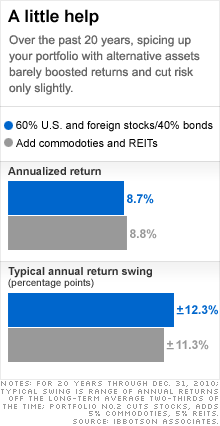NEW YORK (Money) -- How much diversification do I really need? In an attempt to spread risk and maximize return, is it possible to over-diversify a portfolio? -- Nick Poole, Burbank, Calif.
Not only is it possible to overdo diversification, but I believe some advisers and investment firms actually encourage investors to go too far. They do so by touting a smorgasbord of "alternative" investments, ranging from private equity, hedge funds and currencies to absolute-return funds, commodities and ETFs that cover every nook and cranny of the market. (Anyone for a fertilizer ETF? How about aluminum?)

Don't get me wrong. The case for building a portfolio with a broad mix of assets is sound. Spreading your money among a variety of investments that don't all move in lockstep, allows parts of your portfolio to zig while others zag. That gives you the chance to earn a higher long-term return without boosting risk.
But you don't have to assemble a vast array of investments to pull this off. Indeed, you can reap the bulk of the benefits of diversification with a simple portfolio of U.S. stocks and bonds.
The key is to make sure you own a broad range of companies (large and small in all industries) and a wide selection of bonds (government and investment-grade corporates of varying maturities).
If you stopped there, you would do just fine. But just so you're not dependent solely on the performance of the U.S. market, it's a good idea to mix in broad international exposure, including some fast-growing emerging markets.
You can create such a straightforward portfolio by picking individual funds that invest in a specific area -- large caps, small fry, government bonds, corporates, etc.
Or you can do it with as few as three broad index funds that cover virtually all the bases: a total U.S. stock market index fund, a total bond market index and a total international stock index fund, each of which you'll find on our MONEY 70 list of recommended funds at CNNMoney.com.
You can go for even more diversification gusto in hopes of significantly improving performance, but there are no guarantees. As the chart to the left shows, over the past 20 years tossing REITs and commodities into the mix boosted return and lowered risk, but hardly enough to blow your socks off.
Besides, if you have a broadly diversified domestic-foreign mix along the lines I outlined above, you likely already have exposure to these areas. A total stock market index fund, for example, has roughly 15% of its assets in commodity-related operations (energy, mining and agricultural companies) and another 3% or so in REITS and other real estate companies.
If you own a home, you've also got a big bet on real estate there. So before you start throwing money at niche investments and divvying up your portfolio into ever-narrower slices, you'll want to think about whether it's really worth the effort.
The more complicated your portfolio, the more monitoring you'll have to do to keep it on track. Fail to re-balance periodically to restore your far flung holdings, and you could end up with no extra benefit at all.
Similarly, the higher fees that come with many of the more exotic investments could easily wipe out any additional gain. Finally, whatever level of diversity you decide to shoot for, you need to be realistic about the actual benefit you'll get.
Spreading your money among a variety of asset classes can certainly dampen the ups and downs of your portfolio, but it doesn't necessarily provide shelter during big market cataclysms. When U.S. stocks lost half their value from late 2007 to early 2009, foreign shares fared even worse (losing 57%), as did emerging markets (down 62%) and REITs (down 65%).
Bottom line: You can get all the diversification you need from a basic portfolio of U.S. stocks and bonds and, if you want to go the extra mile, international shares. Anything beyond that might help, but probably not as much as just saving another percentage or so of your salary.
Got a question for the Help Desk? Send it to helpdesk@cnnmoney.com. ![]()

Carlos Rodriguez is trying to rid himself of $15,000 in credit card debt, while paying his mortgage and saving for his son's college education.
| Overnight Avg Rate | Latest | Change | Last Week |
|---|---|---|---|
| 30 yr fixed | 3.80% | 3.88% | |
| 15 yr fixed | 3.20% | 3.23% | |
| 5/1 ARM | 3.84% | 3.88% | |
| 30 yr refi | 3.82% | 3.93% | |
| 15 yr refi | 3.20% | 3.23% |
Today's featured rates: